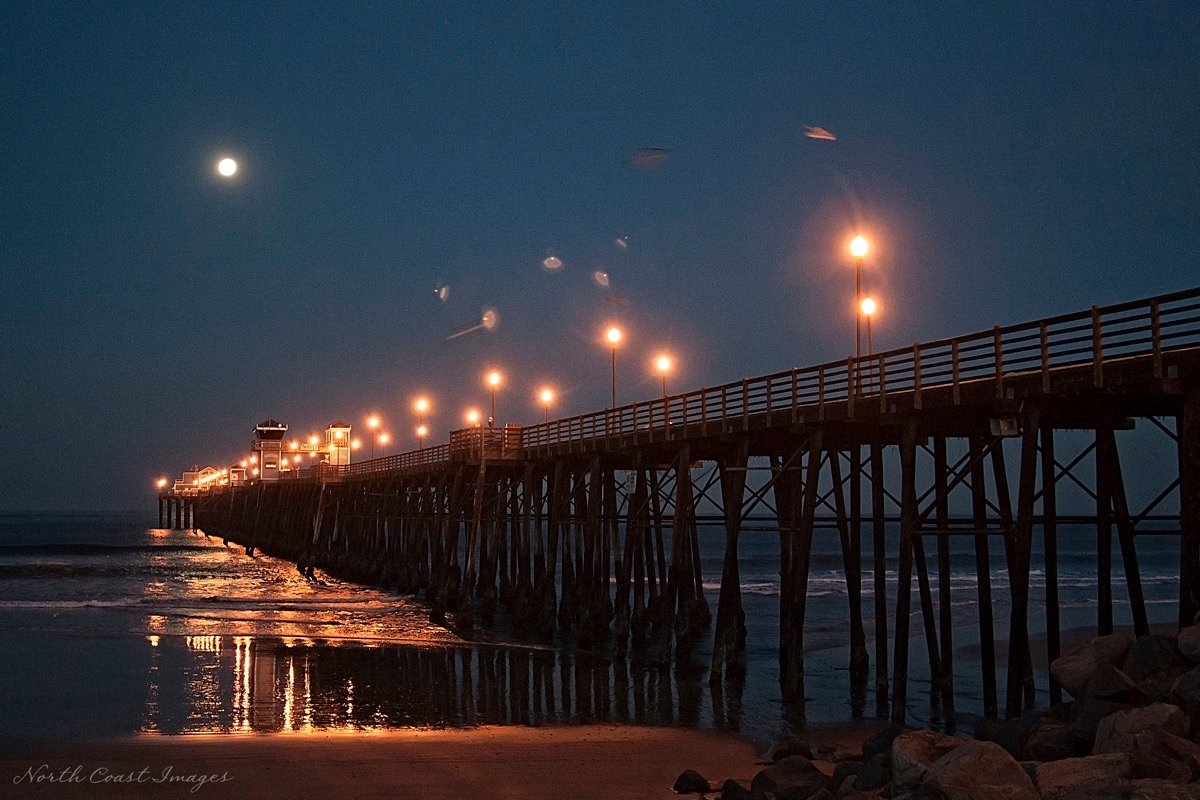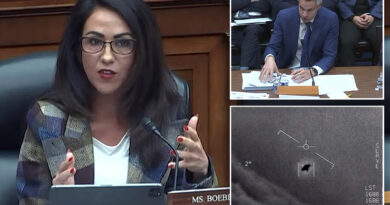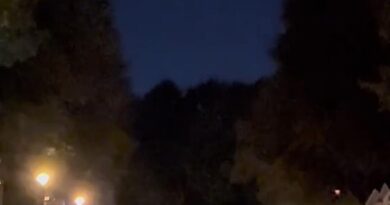Carlsbad woman’s bizarre photo brings UFO conversation home
OCEANSIDE — At approximately 4 a.m. in May 2014, Carlsbad photographer Ann Patterson’s intended subject was the moon, but her camera appeared to capture something unseen by her naked eye: a fluorescent bell-shaped object teetering over the Oceanside pier.
While it remains unclear what exactly the photo portrays (lights, reflections, dust, glare or perhaps a UFO), Patterson, who would not say she physically saw the object, is confident she captured something other-worldly at the iconic North County dock.
“Strange things happen there,” Patterson said.
The peculiar relationship between UFO sightings and the San Diego coast was deferred to a closed session on May 17 during the U.S. House of Representatives Intelligence Counterterrorism, Counterintelligence and Counterproliferation subcommittee hearing.
However, Pentagon officials did tell lawmakers that UFOs (more recently termed “unidentified aerial phenomena,” or UAPs) are not aliens.
“We have detected no emanations within the UAP Task Force that would suggest it is anything nonterrestrial in origin,” said Scott Bray, deputy director of Naval Intelligence.
The congressional hearing — the first in more than 50 years on the subject — unveiled a shadowy organization that quietly restarted the efforts of Project Blue Book, an Air Force program for the investigation of UFOs that concluded in 1969.

According to Ronald Moultrie, undersecretary of defense for intelligence and security, the role of the Airborne Object Identification and Management Synchronization Group is “to facilitate the identification of previously unknown or unidentified airborne objects in a methodical, logical and standardized manner.”
The recently-formed group is the successor to the U.S. Navy’s Unidentified Aerial Phenomena Task Force and was added to this year’s National Defense Authorization Act, marking the first dollars allocated to UAPs in a decade.
“Unidentified aerial phenomena are a potential national security threat, and they need to be treated that way,” Chairman André Carson Carson (D-Indiana) told fellow committee members. “For too long, the stigma associated with UAPs has gotten in the way of good intelligence analysis. Pilots avoided reporting or were laughed at when they did. Today, we know better. UAPs are unexplained, it’s true, but they are real. They need to be investigated, and any threats they pose need to be mitigated.”
However, not everyone is convinced these strange encounters are a national threat.
The C3 Hearing
Despite Project Blue Book’s earlier finding that “no UFO reported, investigated, and evaluated by the Air Force has ever given any indication of threat to our national security,” the Office of the Director of National Intelligence released a whitepaper last year concluding UAPs pose a flight safety issue for aviators and “may pose a challenge to U.S. national security.”
“Our aviators train as they would fight,” Bray told lawmakers. “So any intrusions that may compromise the security of our operations by revealing our capabilities, our tactics, techniques, or procedures are of great concern to the Navy and the Department of Defense.”
The nine-page document, “Preliminary Assessment on Unidentified Aerial Phenomena,” reflects unexplained occurrences between November 2004 to March 2021. (Since sightings of UAPs date back to the 1940s and were not consistently reported, this was the tailored dataset used to analyze these events.)
In 2021, there were 144 unexplained sightings recorded — one object was conclusively identified as a large, deflated balloon. But this past year, UAP encounters nearly doubled due to streamlining reports and destigmatization. Pentagon officials told lawmakers there are now 400 — and counting — unexplained incidents sitting in the UAP database.
The U.S. military has never made an attempt to contact a UAP, nor were any collisions reported between these objects and aviators. However, Bray said there have been 11 “near misses” between UAPs and aviators between 2004 and 2021.
Subcommittee members encouraged the intelligence agencies to diversify the data pool, as the Federal Aviation Administration was the only non-military agency that Pentagon officials confirmed collected UAP data.
“I think standardized reporting without a doubt is key to helping us ascertain what some of these are,” Bray said, concerning adopting a citizen-based reporting system.
However, there may be added caution when welcoming public insight.
“This isn’t just happening to members of the military, let’s be honest,” said Katie Howland, a humanitarian and UAP advocate based in San Diego. “I think the biggest thing we need to do is destigmatize the conversation and not label people who say they’ve seen something strange as weird or crazy.”
Howland said that science is built on the unknown and the government should welcome some input from outside the military.
“Every bit of scientific knowledge started off as something that was impossible or weird, so I think we just have to treat it as exactly that,” Howland said, referring to public, unofficial reports as “data points.”
USS Nimitz and California
Patterson said she set her alarm for 4 a.m.
“My intent was to get the moon over the pier,” Patterson said about the strange image she captured in 2014.
“I thought what the hell?” and headed out to the Oceanside pier.
The Carlsbad resident said she was shocked to see the obscure, bell-shaped light — which appeared to dance across the frame.
“But I couldn’t see it with my naked eye,” she explained.
The photo’s metadata confirms the picture was created on May 14, 2014, and indicated the image was modified two days later. Patterson explained she enhanced the photos and inserted her company watermark but did not alter the images beyond that. The Coast News was not able to independently verify the object seen in the photo.
Patterson isn’t the only one who has seen odd things off the coast near Camp Pendleton.
While sightings of unidentified flying objects date back decades, the Pentagon directed two staff members to shuffle through 20 years of data, starting with odd encounters reported by the USS Nimitz and USS Princeton.
In November 2004, occasions of multiple UAPs were detected several times within the training zone of the Nimitz Carrier Strike Group off the coast of San Diego — the “genesis of modern conversation,” Howland said.
“[The USS Nimitz and USS Princeton] had a number of days where there were anomalous sightings, the UAP Task Force actually brought up this encounter in their hearing as being still unexplained and one of the most remarkable cases,” Howland said.
While preparing for deployment to the Arabian Sea, four naval aviators witnessed “an elongated egg or Tic Tac” the size of a fighter jet hovering over a “disturbance” under the ocean’s surface. Witnesses described the object as “solid white” and “smooth with no edges.”
Reports of that incident reflect clear skies and calm waters that day.
“There was something churning underneath the water that it seemed to be interacting with intelligently,” Howland said about the event.
Retired U.S. Navy Lieutenant Commander Alex Dietrich and Officer David Fravor, each piloting fighter jets with backseaters, were sent to investigate the object hovering just above the water.
“It’s pointing north-south and it’s just going forward, back, left, right,” Fravor said in an interview with NBC in April 2021.
While Dietrich stays high, Fravor dives low to get a closer look at the object.
“And then it starts coming up at us,” Fravor said.
The wingless object then began to mimic Fravor’s flight patterns.
“So, it’s literally aware that we’re there, there’s no doubt,” Fravor said in the interview. “It mirrored me.”

Then, the strange vessel disappeared. It was later confirmed that the USS Princeton had been detecting “multiple anomalous aerial vehicles” operating in the vicinity of the Nimitz training group and descending “very rapidly from approximately 60,000 feet down to approximately 50 feet in a matter of seconds.”
In 2019, the U.S. Navy confirmed three videos circulating the web — FLIR1, Gimbal and Go Fast — “show incursions into our military training ranges by unidentified aerial phenomena.” In FLIR1, a 2004 video depicting the “Nimitz incident,” shows an oblong-shaped object darting away from military sensors.
There are the “five observables,” or traits most commonly associated with UAPs: no visible sign of propulsion, sudden/instantaneous acceleration, no signatures following hypersonic velocities, low observability and trans-medium travel (i.e. interacting with the air and sea).
When asked about unidentified submersible objects – or objects that have been located underwater – subcommittee members were deferred to a closed session with Pentagon officials.
While the location of most military UFO sightings are unclear, California is the top reporting spot for civilian sightings.
When asked about the connection between trans-medium travel and coastal towns, Howland speculates there’s declassified information the public would be interested in.
“There’s a lot of questions about this,” Howland said. “One of the members of Congress explicitly asked about unidentified submersible objects [during the hearing], and they relegated that conversation to the classified briefing. When I hear that something’s being relegated, that typically means there’s something to it that they want to discuss. So, there’s definitely a tie there.”
According to the National UFO Reporting Center, California and Florida have, in some cases, more than 10 times the number of reported sightings than other states. California has more than 15,000 cases, and Florida has 7,612. Other states, for example, have between 265 in North Dakota and 4,000 in Pennsylvania.
The UFO Reporting Center was founded in 1974 by noted UFO investigator Robert J. Gribble. In 1996, it began as an online public database. According to its website, federal law enforcement entities routinely directed UAP calls to the center.
What are UAP?
Juan Flores Mendez was a child when he was given his first telescope. Mendez, who is now in his 40s, has lived near San Bernardino in rural areas most of his life. He currently lives in Fulton, a census-designated town with a population of 413.
Mendez said he has seen hundreds of UFOs in his lifetime, attributing the persistent sightings to his rural life. There’s no light pollution, Mendez said, so he’s able to freely examine the night sky.
When asked about the intelligence hearing, Mendez said he was happy there was official evidence to confirm his belief. However, he’s concerned with any investigation being too military-focused.
“I think they’re just observing,” Mendez said.
Patterson, too, believes that UAPs are something off-world; however, her only evidence was seemingly caught through a lens during these odd hours of the morning. Patterson’s image could resemble the shape of a UAP that was videoed going 120 knots against the wind by a U.S. Navy pilot in 2015. Or it could be refracted light from the night sky and lights on the pier.
These unknown entities in the 2004-2021 dataset were registered across multiple sensors, including radar, infrared and weapon-seeking observations — all measurements that confirm UAPs are physical objects.
UAP investigation “usually” results in one of several categorizations, according to officials.
- Airborne clutter
- Natural atmospheric phenomena
- U.S. government or industry developments
- Foreign adversary systems
- Unexplained sightings that merit further investigation
The term “UAP” is used when all other explanations can be ruled out — sightings that lead to further investigations.
While officials are unsure the exact threat posed by UAP, they’re sure these mysterious aerial vessels clutter the air, creating a risky environment for servicemen. The assessment states UAP would represent a national security challenge “if they are foreign adversary collection platforms or provide evidence a potential adversary has developed either a breakthrough or disruptive technology,”
Bray confirmed on May 17 that the United States is not aware of any foreign adversary capable of moving objects without any discernible means of propulsion.
FLIR1
[embedded content]
Gimbal
[embedded content]
Go Fast
[embedded content]
It’s also highly unlikely that UAPs are domestic experiments as well, considering the consistency of reports over decades and the seemingly-advanced technology.
“We have black technologies and capabilities that are not publicly known,” Howland said, “But if you look at what these [UAPs] are known to do, these crafts can go up to 13,000 miles per hour.”
UAPs have been clocked just more than six times the speed of the fastest jet aircraft in the world. The Lockheed SR-71 Blackbird reaches Mach 3.3, more than 2,500 miles per hour, and the follow-up SR-72 is currently in development.
“I believe it’s supposed to go about 4,500 miles per hour,” Howland said. “So to say this is next-generation technology doesn’t cover it. It’s so far beyond what we are even currently developing that I think it just becomes kind of mind boggling, frankly.”
Bray and Moultrie told lawmakers that they can generally categorize UAPs as unmanned aircraft and physical objects.
Friend or foe? Fact or fiction?
The Pentagon tasked itself to confirm the unknown and unknowns, Moultrie said. Of those unknowns, however, is the consideration of civilian reports in official UAP analysis.
“There are fakers and there are people who are trying to make money off this,” Howland said. “There are people who don’t have good intentions.”
Of the 15,000 people in California that have recorded their experiences with the UFO Reporting Center, many are convinced they spotted something unexplainable, but spectacular.
Mendez is the administrator of Southern California UFOs and Aliens Facebook page. While he admittedly said he’s one to listen to conspiracy theories, which is evident on the social media page. However, while taking his elementary schooler to the bus stop early May 19, Mendez told the Coast News, he knew these inexplicable flying objects were real before the government confirmed it in 2017, and again in 2020.
Mendez does believe that UAPs do not pose a threat and stem from a source off-planet, but also agrees there’s harmful information too readily available.
While there’s an argument for direct threat, a 2017-leak of information from Luis Elizando, a former intelligence agent and UAP lead, found that researchers studied people for any physiological changes after some claimed to experience physical effects after encounters with these flying.

“One of their precursor programs that looked at UAP does show that there were some pretty remarkable, essentially radiation poisoning effects on people who have had close encounters,” Howland said.
While Howland agrees UAP are a threat to aviators, she looks forward to more experts entering the conversation.
“We’re going to need to bring in minds that have a diverse view, people who are able to look at the epidemiology of these encounters, the human health impacts and as well as the philosophical questions it brings up, and the religious questions,” Howland said. “It could potentially, depending on the answer, have a big impact on our society as a whole.”
Advocating for the truth
Whether a “truther” or one advocating for government transparency, UAPs have become a bridging issue. Regardless of what UAP are, or the threat they pose, they are real, a fact that Howland anguished over when trying speak on the topic with young intelligence professionals.
“It could be U.S. black tech, it could be a foreign adversary, it could be this weird other category, it doesn’t matter,” Howland said. “Because the bottom line is our airspace was unsafe for our military aviators, and so I was really frustrated that people weren’t taking this seriously.”
Howland is the monitoring and evaluation manager and disaster response team lead at the Free Wheelchair Mission and she has a master’s of public health with a focus in epidemiology.
Howland’s current role as a UAP advocate was not something she planned.
While volunteering for Joe Biden’s presidential campaign, Howland and a cohort young professionals attended a series of speakers, one being former White House Chief of Staff John Podesta, who penned the prologue to Leslie Kean’s “UFOs: Generals, Pilots, and Government Officials Go on the Record.”
That fellowship is now housed at Foreign Policy for America, called the NextGen Initiative — a group of “tomorrow’s intelligence and foreign affairs leaders,” Howland said. However, she couldn’t get her colleague to have a serious conversion about these phenomena.
So, she became dedicated to spreading the word.
“To be a UAP transparency activist is really just committing to follow the evidence, wherever that leads,” Howland said. “Not coming up with any preconceived notions about what the phenomenon is or isn’t, but making sure that the government is following up appropriately and is protecting our citizens and our service members.”
This article has been archived for your research. The original version from Coast News can be found here.


